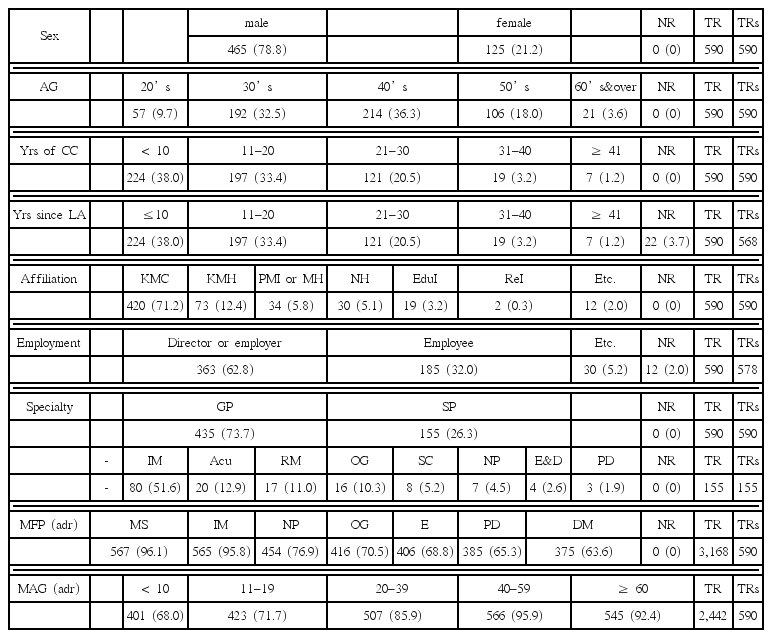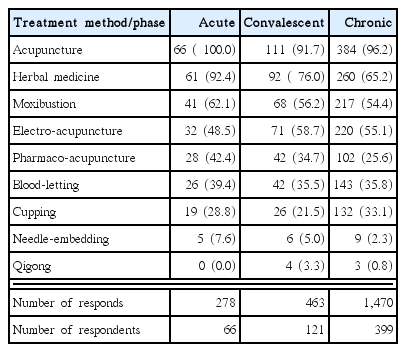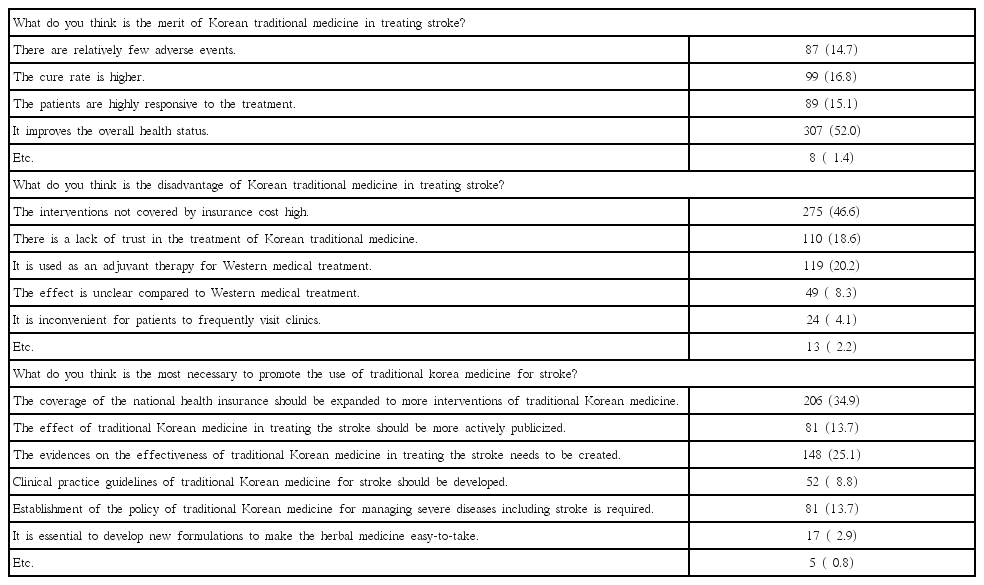References
1. Association of Korean medicine professors for cardiovascular and neurological medicine. Cardiovascular and Neurological Medicine in Korean Medicine Seoul: Wooripub; 2016. p. 243.
2. Feigin VL, Forouzanfar MH, Krishnamurthi R, et al. Global and regional burden of stroke during 1990–2010: findings from the Global Burden of Disease Study 2010. The Lancet 2014;383(9913):245–55.
11. Bak YH, Huang DS, Shin HK. A Survey of the Medical Treatment Environment in Traditional Korean Medicine Clinics. Journal of Korean Oriental Medicine 2011;32(4):25–36.
13. Shin HK. Clinical study on CVA patients in Hospital attached to college of oriental medicine and NMC department oriental medicine. Korean Journal of Oriental Medicine 1995;1(1):1–14.
14. Zhou L, Chen Y, Liu J, et al. Evaluating the implementation of evidence-based TCM Clinical Practice Guidelines for Cerebral Infarction. European Journal of Integrative Medicine 2014;6(2):147–55.
15. Ko MM, Lee JA, Cha MH, et al. Stroke in Traditional Korean Medicine: A Nine-Year Multicentre Community-Based Study in South Korea. Scientific Reports 2016;6:28286.
16. Chang CC, Lee YC, Lin CC, et al. Characteristics of traditional Chinese medicine usage in patients with stroke in Taiwan: a nationwide population-based study. Journal of ethnopharmacology 2016;186:311–21.
17. Yam W, Wilkinson JM. Is acupuncture an acceptable option in stroke rehabilitation? A survey of stroke patients. Complementary therapies in medicine 2010;18(3):143–9.
18. Liao CC, Lin JG, Tsai CC, et al. An investigation of the use of traditional Chinese medicine in stroke patients in Taiwan. Evidence-Based Complementary and Alternative Medicine 2012;2012:387164.
19. Chang CC, Chen TL, Chiu HE, et al. Outcomes after stroke in patients receiving adjuvant therapy with traditional Chinese medicine: A nationwide matched interventional cohort study. Journal of ethnopharmacology 2016;177:46–52.
20. Chen L, Fang J, Ma R, et al. Additional effects of acupuncture on early comprehensive rehabilitation in patients with mild to moderate acute ischemic stroke: a multicenter randomized controlled trial. BMC Complementary and Alternative Medicine 2016;16(1):226.
21. Fang J, Chen L, Ma R, et al. Comprehensive rehabilitation with integrative medicine for subacute stroke: A multicenter randomized controlled trial. Scientific Reports 2016;6:25850.
22. Liu AJ, Li JH, Li HQ, et al. Electroacupuncture for acute ischemic stroke: a meta-analysis of randomized controlled trials. The American journal of Chinese medicine 2015;43(08):1541–66.
23. Zhang T, Zhang L, Zhang HM, et al. Systematic review of acupuncture therapy for acute ischemic stroke. China Journal of Traditional Chinese Medicine and Pharmacy 2009;24(1):101–4.
24. Vados L, Ferreira A, Zhao S, et al. Effectiveness of acupuncture combined with rehabilitation for treatment of acute or subacute stroke: a systematic review. Acupuncture in Medicine 2015;33(3):180–7.
25. Zhang X, Liu XT, Kang DY. GRADE in Systematic Reviews of Acupuncture for Stroke Rehabilitation: Recommendations based on High-Quality Evidence. Scientific Reports 2015;5:16582.
26. Yang A, Wu HM, Tnag JL, et al. Acupuncture for stroke rehabilitation, Cochrane Database of Systematic Reviews. Cochrane Database of Systematic Reviews 2016;26(8):CD004131.
27. Zhang JH, Wang D, Liu M. Overview of systematic reviews and meta-analyses of acupuncture for stroke. Neuroepidemiology 2013;42(1):50–8.
28. Zhang S, Liu M, Asplund K, et al. Acupuncture for acute stroke. Cochrane Database of Systematic Reviews 2005;18(2):CD003317.
29. Zhang S, Wu B, Liu M, et al. Acupuncture efficacy on ischemic stroke recovery multicenter randomized controlled trial in China. Stroke 2015;46(5):1301–6.
30. Shih CC, Liao CC, Sun MF, et al. A retrospective cohort study comparing stroke recurrence rate in ischemic stroke patients with and without acupuncture treatment. Medicine 2015;94(39):e1572.
31. Chuang SF, Shih CC, Yeh CC, et al. Decreased risk of acute myocardial infarction in stroke patients receiving acupuncture treatment: a nationwide matched retrospective cohort study. BMC complementary and alternative medicine 2015;15:318.
32. Wei YX, Zhao X, Zhang BC. Synergistic effect of moxibustion and rehabilitation training in functional recovery of post-stroke spastic hemiplegia. Complementary therapies in medicine 2016;26:55–60.
33. Kuang AK, Wang CX, Zhao GS, et al. Long-term observation on qigong in prevention of stroke--follow-up of 244 hypertensive patients for 18–22 years. Journal of traditional Chinese medicine 1986;6(4):235–8.
34. Han CH. Clinical Practice Guideline of Korean Medicine for Stroke: Preliminary Guideline and Recommendation. Korean Journal of Oriental Internal Medicine 2012;33(4):347–66.
35. Lee MS, Shin BC, Kim JI, et al. Moxibustion for stroke rehabilitation systematic review. Stroke 2010;41(4):817–20.
36. Lee MS, Choi TY, Shin BC, et al. Cupping for stroke rehabilitation: a systematic review. Journal of the neurological sciences 2010;294(1):70–3.
37. Blunt SB, Lee HP. Can traditional “cupping” treatment cause a stroke? Medical hypotheses 2010;74(5):945–9.
38. Leung K, Yan T, Li L. Intracerebral haemorrhage and Qigong. Hong Kong medical journal 2001;7(3):315–8.
39. Liu CH, Hsieh YT, Tseng HP, et al. Acupuncture for a first episode of acute ischaemic stroke: an observer-blinded randomised controlled pilot study. Acupuncture in Medicine 2016;34(5):349–55.
40. Wang C, Wu Z, Li N, et al. Clinical curative effect of electric acupuncture on acute cerebral infarction: a randomized controlled multicenter trial. Journal of Traditional Chinese Medicine 2014;34(6):635–40.
41. González-Fraile E, Martín-Carrasco M, Ballesteros J. Efficacy of MLC601 on functional recovery after stroke: A systematic review and meta-analysis of randomized controlled trials. Brain injury 2016;30(3):267–70.








